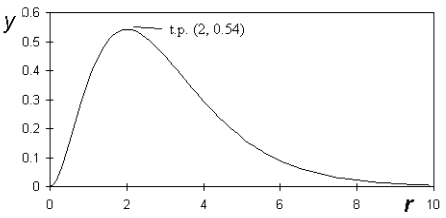1. Answer all parts (a) to (d).
Determine the following:
(a) dy/dx if y = 7x5 (b) dk/dp if k = 6p5 + 21p - 8
(c) db/dq if b = 9tan q (d) dj/dm if j = 21e-12m
(4 marks)
2. Answer all parts (a) to (d). All parts carry equal marks.
Differentiate the following functions with respect to x, and simplify the result where possible:
(a) y = (5x + 1)(7 - 3x) (b) y = 33x5 ln x
(c) ![]() (d) y = cos (x5 - 3x4)
(d) y = cos (x5 - 3x4)
(8 marks)
3) A function which is often used to represent the form of an electronic wavefunction in certain atoms is:
y = r2 e-r
a) This function has 3 stationary points. One is at r = 0, and another at r = infinity. Differentiate this function and thence determine the coordinates (r, y) of the remaining stationary point.
(4 marks)
b) Differentiate this function again, determine whether the stationary point you just found is a local maximum or minimum.
(5 Marks)
c) Hence sketch this function between r = 0 and r = 8.
(3 marks)
1)
a) dy/dx = 35x4 b) dk/dp = 30p4 + 21
c) db/dq = +9 / cos2q d) dj/dm = -252e-12m
2)
a) Product Rule: (5x + 1).(-3) + (7 - 3x).5 = 32 - 30x
b) Product Rule: 33x5(1/x) + (ln x.165 x4) = 33x4 (1 + 5 ln x)
c) Quotient Rule: ![]()
3) a)
Product Rule: dy/dr = -r2e-r + e-r(2r) = re-r(2 - r)
For turning point, re-r(2 - r) = 0, so either:
The last answer is the required one. So the turning point is at (2, 0.54).
b) This is quite tricky:
d2y/dx2 = re-r(-1) + (2-r) [ r(-e-r) + e-r(1)]
= -re-r -2re-r +2e-r + r2e-r - re-r
= e-r (r2 - 4r + 2)
Determine the sign of the second differential, d2y/dr2. Putting in the value of r = 2, we get d2y/dr2 = -0.27, which is -ve, so the t.p. is a local maximum.
c) Sketch. Need to label axes correctly, get correct shape of graph, label t.p. correctly.
